King Country





By Paul Charman
A collection of 1.5 million negatives representing an Ōtorohanga photographer’s entire career is being transferred to the town’s Museum.
The collection of black and white negatives and prints provides a record of more than half a century when Richard and Ruve Wallace ran a photographic business in town.
Plans are underway to store the negatives in a fireproof facility at the museum.
Richard Wallace has been chosen as the featured artist for the town’s Art Beat Festival on the weekend of November 23 and 24.
He will deliver the artist’s talk, followed by questions and a mix and mingle, which will be treated as a send-off for the couple, who will depart soon after to live in Western Australia.
Ōtorohanga Museum Director Liz Cowan said the collection was unique and represents more than half a century during which Richard used his film cameras to record the lives of people in the Ōtorohanga District.
The Wallaces were willing to donate the archive, but the museum insisted on a token payment.
A grant from Trust Waikato helped to secure the negatives, which were taken from 1963 to the mid-2000s when the Wallaces stopped using negatives.
“It is a bit scary because it’s a very big responsibility to do justice to such a valuable taonga. It was so generous of them to hand over the collection,” Cowan said.
“The collection comprises a comprehensive record of weddings, births, community events and significant people in the community.
“It’s such a slice of life, representing so many people, places



and events – very few towns would have an historic record of this sort. The collection has been meticulously catalogued by Ruve; considering that not all photographers from this era kept their negatives it is quite unique.”
A selection of prints from the collection will be on display during the Art Beat festival.
The museum signed a Deed of Significant Acquisition spelling out the conditions to safeguard the “Richard and Ruve Wallace Collection”.
These include keeping the collection whole and together on site in Ōtorohanga and exhibiting the works for the public regularly. The agreement also provides for making copies of certain images which may be requested by descendants of photographic subjects.
• Why the Wallaces pulled the trigger – See page 9

Waitomo Caves has been given hi-tech publicity a galaxy beyond its advertising spending power by one of YouTube’s most followed people.
Jimmy Donaldson, who goes by the name of Mr Beast, uploaded a video of his time at the caves on Sunday and it had more than 67 million views in two days.
Seven Days in a Cave follows Donaldson through the Lost World Cave.
The fast paced, deliberately dramatic video shows how Donaldson and his team led by a guide set up camp and stay in the caves for a week. He also slips in an advert for a toy line which carries his name.
Waitomo Adventures chief Nick Andreef said he expects the benefits of the publicity to rub off not only on the



caves, but also the country’s tourism.
“His audience tends to be young adults, teenagers,” he said.
Mr Beast sought them out. There is a request pinned to the comments of the post, “What survival challenge should I try next?”
The making of the video involved round the clock work for a week involving about 50 staff in addition to Donaldson and his support crew underground.
“There was fibre optics throughout the cave and they were editing in real time back in North Carolina,” Andreef said.
He said the crew spent a further two days ensuring nothing had been left in the caves.


www.baileyingham.co.nz
18 Maniapoto St, Ōtorohanga 07 873 7325 info@baileyingham.co.nz
By Chris Gardner
Western Waikato police officer Dave Hall says he is humbled after winning a prestigious police fellowship worth up to $80,000.
Douglas received a fellowship in 2023, following Sgt Jarod Walsh in 2019, and Snr Constable Richard Collier in 2018.








Book your advertising space janine@goodlocal.nz

News/Editorial
Roy Pilot editor@goodlocal.nz
027 450 0115
Andy Campbell andy@goodlocal.nz 021 0232 1666
Paul Charman paul@goodlocal.nz 027 405 9038
Sigrid Christiansen sigrid@goodlocal.nz 022 080 6141
Advertising Director
Janine Davy janine@goodlocal.nz 027 287 0005
Owner/Publisher David Mackenzie david@goodlocal.nz Office 07 878 1188 reception@goodlocal.nz
Readers’ contributions of articles and
Publication of contributions are
at the
of editorial staff and may be edited. Contributions will only be considered for publication when accompanied by the author’s full name, residential address, and telephone number. Opinions expressed are not necessarily those of the publishers.
The King Country News is published by Good Local Media Ltd
Waikato West Area prevention manager senior sergeant Hall, whose police jurisdiction goes from Huntly in the north to Te Kūiti in the south, is one of 18 police officers nationally who have been awarded a Woolf Fisher Police Fellowship after an anonymous nomination from a colleague.
Seventy-seven officers were nominated for the fellowship.
Te Awamutu based Hall, who has served in the police for 31 years, was presented with the fellowship at police national headquarters in Wellington on Friday after an invitation from commissioner of police Andrew Coster.
“It was very humbling to be nominated by my peers,” he said.
“Knowing the people in Waikato that have received the award in the past I have some high standards to follow.”
Waikato officer Natalie
The purpose of the fellowship is to promote better and more efficient policing for community benefit. The fellowship covers travel, study, and associated costs of the fellow and an accompanying partner. Fellows’ study may include observation of policing practices in overseas jurisdictions, participation in a pre-agreed course of study, or both, and they are required to report back on their learning on their return.
The fellowship offered exciting opportunities to canvass some international approaches to crime, Hall said.
“I am currently looking at a trip to North America.”
Hall will be joined by his wife Tania, a teacher at Paterangi School.
He will get eight weeks paid leave in which to travel and write a report on his findings.
Inspector Will Loughrin have said Hall was a hugely deserving recipient who had worked hard
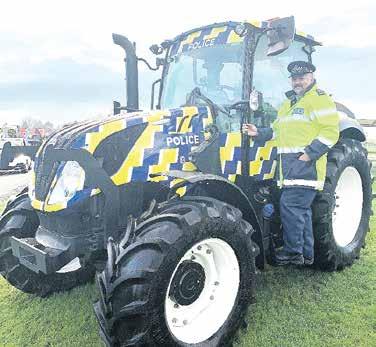
for the organisation and his people, and communities, never asking for anything in return.
Hall is the manager of Te Awamutu Football Club’s Men’s under 23-year-olds team and the Te Awamutu College football co-ordinator.
The Woolf Fisher Trust was
Woolf Fisher Police Fellowships were added to the trust’s offering in 2017.
Hato Hone St John says strike action planned from Saturday will cause minimal disruption to the public.
St John received notification from First Union and the Amalgamated Workers Union NZ that its members would withdraw labour for four hours from the start of their shifts on Tuesday and Saturday this week.
St John’s deputy chief executive for ambulance operations, Dan Ohs, said patient safety remained the focus and the organisation was doing all it could to reduce the impact on patients during the strike periods.
“…if you have an emergency, you should still dial 111. If your call is not immediately life threatening, there may be a delay, or you may be asked to self-transport to a medical facility if it is considered safe for you to do so,” he said.
“For all non-emergencies we are asking people to contact Healthline, their GP, or their local pharmacy in the first instance.”
St John has been in bargaining with the unions since the beginning of this year, following agreements expiring last November.
The King Country News Office in Te Kūiti had a supersized visitor when contractor Rob Burgess pulled up in this Case 200 CVT –obviously top of its field.
Why bring that much horsepower to town? He had to drop off a muck spreader, (unless he was pulling our legs).
The digger/bulldozer/tractor driver is working on Ranginui Station near Mangakino and said it took him two hours to drive to town at 50km/h.
“It was fine, there’s not too much traffic on

the road today,” he said. “It’s nice doing 50ks along the road, you get to see the countryside.”
And the most important question – did the parking gods smile on him? Yes indeed – and that’s not really a ‘turnip’ for the books, it’s just one of the many reasons people love the King Country town.
Kāwhia forest owners say they will hold a public meeting to discuss the 10-15 logging trucks a day entering and leaving the township during logging of the forest between the town and the hotwater beach.
Logging started on Monday. Tainui Kāwhia Incorporation (TKI) is a whānau owned and operated business that owns the 1000-hectare forest estate.
The forest was established in the late 1960’s and early 1970’s as an environmental and community protection project to prevent the large sand dune encroaching on Kāwhia.
The first harvest took place in the 1990’s and the second cut is now underway.
The public meeting, at a date still to be set, will discuss logging truck movements.
King




















The text alerts were probably genuine, but the “staff member” at the end of the phone wasn’t. Paul Charman reports on how an out of the blue call resulted in a small fortune being stolen.
A Te Kūiti woman defrauded of $48,000 by scammers on August 6 has received $40,000 back from her bank.
The remaining $8000, which was the limit of a credit card account emptied by the scammers, is still outstanding.
Alison (not her real name) said she felt stupid for not spotting the scam but had not been on her “A game” the day the scammers struck.
She spoke to The News on condition we didn’t identify her –and was able to give an insight into the tactics of the thieves.
The BNZ subsequently told her the $40,000 had been deposited into an account run by Revolute, an English company similar to Travelex.
The bank contacted Revolute and arranged to retrieve the money.
The fraudster, who sounded like a young woman, called in the early evening telling Alison that she was from the BNZ fraud team.
“She said she believed that I had been scammed. But apparently at the same time I was getting text alerts from the BNZ saying I might be being scammed, so it all sort of fitted in and I just went ahead basically.
“I think the text alerts were genuine, but I didn’t realise the caller was the scammer.
“I was suspicious because she didn’t speak clearly. She had an ordinary voice, spoke quite fast and was not issuing clear instructions. But there was no accent - I felt like she was a New Zealand person.”
The scammer asked Alison what make of her phone she was using, and to list her other devices used for mobile banking.
“She said I needed to uninstall my BNZ app which I reluctantly did. She then emailed me codes which I
By Sigrid Christiansen
Ōtorohanga has lost half of its popular pair of kea while three of its kākā flourish in a new east coast environment.
Twenty-eight-year-old Mati was euthanised after it became evident she was suffering.
Mati spent the 11 of her 28 years at the Ōtorohanga Kiwi House and with Zeppelin – now 38 – formed a breeding pair.
Kea are an alpine parrot regarded as one the most intelligent of all birds. The conservation department estimated their numbers in 2021 at between 3000 and 7000.
Despite being strong fliers, they spend a lot of time on the ground and are vulnerable to introduced predators.
“Mati was a doting mum and sometimes domineering mate,” manager Jo Russell said. “Her alarm call could be heard across the park, in particular if kākā youngsters were a bit too raucous.”
Ōtorohanga is one of three centres where kea are bred, usually from birds which have been injured, and their chicks form what the department calls an advocacy population which can be viewed by the public
Meanwhile, three kākā, bred at the Ōtorohanga Kiwi House and released on the east coast at Cape Kidnappers on July 15, are enjoying their newfound freedom, Cape Sanctuary general manager Rachel Ward reports.
Te Kawa and her younger sisters Rākaunui and Raumati arrived at the 2500ha predator free sanctuary on June 6.
“We sight them fairly regularly at the feeders, but they are free to come and go,” Ward said.
“They are exploring the rest of site and beyond. We are happy they’re being guided around their new home.”
After time in an aviary as part of a “soft release” two of them spent a further week roosting inside after the doors were opened, but quickly gained confidence.
“Once they were no longer spotted coming in at night on the trail cams, we closed up the aviary. They are truly wild now.

Te Kawa acted as the leader and flew outside first.
“She was very confident in approaching the feeders and interacting with the wild birds. They are fed year-round here, so we are here to support them whenever they feel like they need it.”
Jo Russell said it was Te Kawa’s second time exploring her freedom after surviving a near-drowning in an effluent pond last year, when she was initially released.
She was nursed back to health and given time to regrow her tail feathers which were damaged in the recovery effort.
Later, she joined her sisters at the time of their planned release at Cape Sanctuary.
Russell said genetic diversity was the reason for taking the kākā to the East Coast. Others go to Sanctuary Mountain Maungatautari.
Te Kawa, Rākaunui and Raumati are the offspring of reliable Kiwi House breeding pair, Raki and Toki.
“We just hope they produce some boys soon,” Russell said.
had to repeat back to her and put into my BNZ app, but as I’d just uninstalled, I couldn’t do that.
However, the process to that point had enabled the scammers to access to Alison’s accounts.
Alison heard from the real BNZ the next morning. They had been trying to phone her during the scam, but she missed their calls because she was already on the phone.
“They had been suspicious and put a hold on the transactions, but not a block, so I guess that’s why they were able to get some of the money back.”
Alison said she felt stupid but had been vulnerable at the time. While recently overseas the neighbours’ stock ruined her garden, then she’d caught Covid upon her return and was recovering when the scammer struck. What message would she pass on to others?
“Certainly if you are suspicious don’t be afraid to hang up on the caller; don’t ever believe they need to know what brand of phone you are using. And don’t think you are being rude by ending the call. Just hang up if you’re not sure and ring your bank.”
An 18-year-old Ōtorohanga man has been arrested after a highly publicised ramming of a police vehicle in Hamilton on Saturday night.
Photos of the man and a ute allegedly involved were widely distributed across media after the incident, which happened during a police response to a large gathering of road users.
Detective Sergeant Matt Lee said police executed search warrants at two Ōtorohanga properties, and made enquiries in Huntly, where a freshly painted ute believed to have been involved in the ramming was found. The vehicle was seized and taken away for forensic examination.
The Otorohanga man is charged with intentional damage causing danger to life, dangerous driving, and receiving stolen property.
He was bailed to appear in the Hamilton District Court tomorrow.
The Ōtorohanga teenager’s charges relate to one of four incidents in which police vehicles were rammed on Saturday night, Lee said.
A police officer was knocked to the ground and was lucky to suffer only minor injuries, he said.
Over the course of several hours, police said more than 1000 antisocial road users took part in illegal street racing, before hostile individuals began to throwing projectiles, discharging fireworks and shining lasers at Police.
Police impounded five vehicles and issued more than 100 infringements, 20 green stickers and eight pink stickers.
Videos of the event assisted in the arrest Lee said.


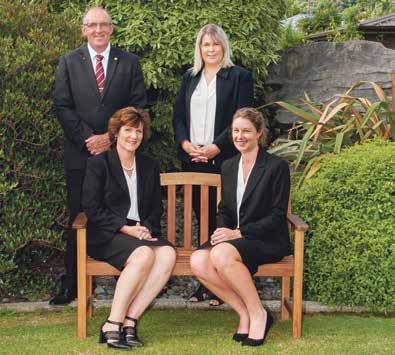




By Andy Campbell
Waitomo deputy mayor Allan Goddard has suggested meetings with community halls committees to discuss rising insurance costs.
Some of the rural hall operators were already struggling to pay insurance costs – and some were considering not continuing with insurance, he said.
“Benneydale alone is up over $6000, Māhoenui is up over $3000,” he told last week’s Audit and Risk Committee meeting.
“It think there might be a need

before the next insurance renewal, that we get back to them and talk to them about the level of cover. We
have it done it before but since then prices have gone up again.”
Chair Jaydene Kana noted other
councils recognised the age of certain buildings and taken the risk not to insure and therefore not pass on the cost, but added “I’m not advocating”.
A report from asset accountant Wayne La Roche and chief financial officer Tina Hitchen said the council’s insurance premiums for the 2023/24 financial year were $442,000 – up from $351,000 last year.
The increase was mainly driven by a rises in premiums as a result of unprecedented natural disasters, nationally and globally.
Insurers were wanting to reduce their risk exposures at a time when the council’s asset values were increased for inflation and additional assets including the Gallagher Recreation Centre were added. The value insured under the material damage policy rose from $133 million to $175 million. Public and professional liability insurance cost to council increased from $54,000 to $66,000 – that was primarily driven by uncertainty and high risk in building control work and the challenging insurance market.
By Andy Campbell
More meetings are to be held between whānau and/or their representatives over grievances surrounding the Waitomo District Council’s Hetet Reservoir.
The council is proposing to replace the reservoir as part of an estimated $9 million water supply upgrade.
The council’s Te Raangai Whakakaupapa Koorero (Māori Relations Committee) work plan for last week’s meeting stated committee members have had meetings with Holland/Searancke whānau representatives. There have also been other meetings convened between whānau representatives and council staff relating to the Hetet Water Reservoir portion of the Resilience project.
Mayor John Robetson revealed in October 2022 the neighbours were concerned about the state of the reservoir which is just less than 20 metres from the old Hetet house.
Speaking at the October 2022 council meeting where council voted to spend nearly $9 million upgrading the town’s water supply, he encouraged council staff to engage with the residents.

“They have watched that old reservoir up there for years - the reason they contacted me was just some questions around its state.”
He noted a risk in network and operational shortcomings had been identified when a consultant mapped the system in 2007.
The water resilience project includes the construction of a 1500-2500 cubic metre reservoir, a rising main along the best route from the water treatment plant to the reservoir and a gravity main through farmland to the Hospital Reservoir to supply the hospital zone while maintenance is performed on the existing reservoir or additional supply into the zone is required.
Included is the installation of new high lift pumps at the water treatment plant to exclusively supply the proposed Hetet Reservoir and necessary valves around the network and completing ancillary work on the Blackmans, Mangarino, Hetet and Hospital Reservoirs.
Te Kūiti’s drinking water system works by filling the reservoirs from the treatment station beside the Mangaokewa stream by first filling the reticulation pipe network – instead of the reservoirs being filled directly from the treatment station and then gravity
feeding the reticulation.
The vulnerability of the system was exposed in the summer of 2022 when a burst main caused the reservoirs to drain rapidly, and nearly run the town out of water. The water treatment plant took days to restore levels.







Andy Campbell
A Waitomo district council survey of what style of Māori representation is desired by the district’s tāngata whenua has returned a firm ‘don’t know’ – at this stage.
Te Raangai Whakakaupapa Koorero (TRWK) committee members have spent the last year doing the rounds of district marae to discuss representation options. The council decided last October to not introduce Māori Wards for the 2025 and 2028 elections.
Instead it decided to work with mana whenua through TRWK to find a representation model that enhanced relationships and provided a platform to discuss and advance issues of interest to Māori.
Not all whare favoured the establishment of Māori wards, committee chair Eady Manawaiti told council in November. The subsequent consultation with each whare as to how they wanted to engage with council, resulted in mixed feedback.
There are seven Whare o Te Nehenehenui, five within the Waitomo District. They are Te Whare ki Rereahu, Te Whare ki Mōkau ki Runga, Te Whare ki Tuhua Hikurangi, Te Whare ki Tokanganui a Noho and Te Whare Hau-ā-uru ki Uta.
Te Whare Tokanganui a Noho (Te Kūiti) expressed disappointment about the process followed and did not believe consultation was genuine, council chief executive Ben Smit said. There was no suggestion on a
model that may work going forward. Issues were also raised about the feasibility of a committee with whare representatives when they had busy volunteer schedules and a two-year term which did not match up with council three-year terms.
Te Whare ki Mōkau ki Runga were the most interested in a committee structure model with representatives from each whare. Te Whare ki Rereahu, was more interested in meeting one on one with council rather than being part of a committee.
The committee met with Te Whare Hauaauru ki Uta, shortly before the committee meeting.
After a meeting in Te Kūiti, Te Runanga o Ngāti Mahuta ki te Hauāuru had not returned with feedback from their wider whānau.
“Due to the mixed nature of the responses from whare and no clear way forward, officers are unable to provide advice to the committee on the best course of action. It may be that a mixed model is preferred,” Smit said.
Options included: Forming a committee to create a strategic plan for Māori in the district, form a committee with representatives from each whare, continue to meet with whare biannually or as needed.
“There is a risk of taking too long to begin a new model for Māori representation that momentum will be lost, and nothing will be bedded in prior to the 2025 elections. Whare may lose interest in the process,” Smit said.

Solutions from other districts include Together Te Tauihu strategy which involves the Nelson, Tasman, Marlborough district councils and eight iwi.
The partnership meets annually to review the strategic plan, which has a focus on being good ancestors. The partners engage in shared decisionmaking forums for dialogue and to co-design significant practices and policies ensuring Māori perspectives are integral to the process. The group decides together on shared priorities for the region.
Kāpiti has a district council committee – Te Whakaminenga o Kāpiti comprising a councillor, the mayor and one representative each from the local iwi authority, a marae management committee and a charitable Trust.
Every six weeks it discusses matters of social, environmental, economic and cultural significance to tangata whenua. Committee members have voting rights around the table, but the committee has not been delegated decision making powers.
If TRWK was to meet informally with whare twice a year, it could not be formal committee meetings. The committee would then meet about every three months to go over the discussion items and make recommendations to council for decision making.
None of the options give Māori the decision-making power of a council vote from a ward seat, or direct input into decision making.
By Paul Charman
A Ruapehu District Council debate on whether or not to keep Māori wards was a distraction from more pressing matters.
That’s the view of councillor Fiona Kahukura Hadley-Chase, who says many people in towns with high Māori populations are facing a crisis of economic deprivation.
“There is a financial crisis all over the country, but it is particularly bad in places like Taumarunui, Raetihi and Te Kūiti where the proportion of Māori is at the highest,” Kahukura HadleyChase said.
“In Ruapehu the deprivation Index score is set at 10, and you can’t get any worse than that.”
The index was compiled by the Ministry of Business Innovation and Employment (MBIE), measuring factors such as household incomes, employment rates, rent affordability and tertiary education.
“My view is that of course we should keep Māori wards; active representation from the group in the community who are most in need can only be a good thing. It dismays me we’re now being forced to dig up the issue and go over all the arguments. It’s such a waste of time, the council and ratepayer resources and people’s energy.”
The only way for communities to go forward was to look at things

The Lines Company (TLC) awards scholarships to three local students each year who are attending tertiary education, providing recognition and financial support


that impact the local economy and its people, she said.
“We must respond effectively to the needs here, but first we must foster inclusivity and embrace diversity. There are people here of various economic scales, colours, cultures and beliefs. We’ll only move forward if everyone gets on the same waka.”
Māori had made huge contributions to society and the council would need Māori wards at the table to be able to move with them, she argued. She said Ruapehu was in “pretty poor shape”, having worn out infrastructure and water assets, ski-field closures threatened, rising power prices and the Chateau dormant.
The priority had been ‘what can we do and how can we make money’ but she believed the question should be, ‘what can we do to make this sustainable, so that what we do now won’t become a headache for our mokopuna?’



For each year of


Drop-in to get
• support with your health app
• tips for staying safe online
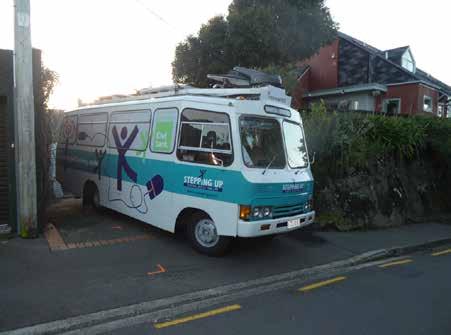
• tech help with your smartphone or tablet
Mon 26 Aug
Tue 27 Aug
Wed 28 Aug
Thu 29 Aug
Fri 30 Aug
Mon 2 Sep to Fri 6 Sep

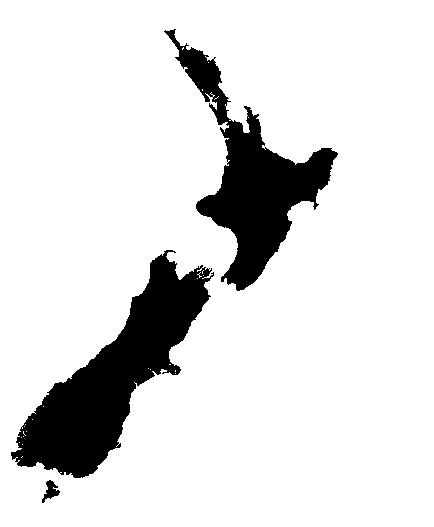
Countdown, 119 Maniapoto St, Ōtorohanga
Village Green, Maniapoto St, Ōtorohanga
Ōpārau Roadhouse, 4370 Kawhia Rd, Ōpārau
Tokanui Hall, Te Kawa Crossroads
Kāwhia Medical Centre, Jervois St, Kāwhia
Village Green, Maniapoto St, Ōtorohanga
Countdown, 119 Maniapoto St, Ōtorohanga
Village Green, Maniapoto St, Ōtorohanga



Time 10am-12pm 12:30pm-4pm 10am-4pm 10am-4pm 10am-4pm 10am-12pm 12:30pm-4pm 10am-4pm












By Paul Charman
With 60,000 members nationwide Grey Power has a level of political clout politicians ignore to their peril.
So says King Country Grey Power president Laurie Hancock, who attended a meeting about 10 years ago because he wanted to feel more part of his community.
Now the president of the King Country branch, which serves people in both Waitomo and Ōtorohanga districts, he says the organisation is not to be under-estimated.
“Grey Power is a quiet achiever, working behind the scenes to advocate for the aged,” he says.
“At a regional level we pick up on issues concerning our members. These get passed on to our national organisation whose subcommittees have areas of responsibility like health, disability or crime. When a serious issue comes up chairs of these sub-committees arrange to meet with the relevant government minister and put our concerns directly.”
The 78-year-old Ōtorohanga resident says the organisation offers the enjoyment of associating with an age group sharing similar concerns.
“None of us want to walk down the street and trip over a cobblestone that’s out of place. We have good relationships with the mayors of Te Kūiti and Ōtorohanga and if it’s an issue with mobility scooters facing a hazard when negotiating a tricky curb, or whatever, we’re listened to.”
The organisation meets at St Luke’s Church in Te Kūiti, holding an open public meeting with a guest speaker every second month.
On alternate months there is a committee meeting at which members consider information released from the national




organisation and members of the public are allowed to sit in.
“Our guest speakers are drawn from organisations such as Neighbourhood Support, the police and others,” Laurie said.
“Neighbourhood Support helps older people understand what’s happening in their community and what to do if they have a concern. The remind us to make getting to know our neighbours a priority and take an interest in what is going on in our street.”
What particular concerns do aged people have in the King Country?
“Generally speaking we are better off than our friends in the big centres because housing prices are more affordable. But if the aged person concerned is renting, even here at $400 to $500 a week, things can be just as hard.
“We are also keeping an eye on scams which are currently a huge problem for elderly people.
Other concerns included availability of healthcare and overcoming the distance involved access to it. Loneliness and the sense of isolation were huge problems in rural areas.
“There are organisations providing services in the attempt to alleviate this and we aged people have to do our level best to take advantage of what is there for us. If you’re lonely your family can help, of course, but if they are not around look at the organisations which are. Go to the Citizens Advice Bureau or if you know somebody in Grey Power talk to them. Contact Aged Concern.
We have not heard too much about elder abuse, but we know it’s out there. This takes the form of physical, emotional or spiritual abuse. If you’re in this position reach out and we’ll try to help.”





















By Paul Charman
The scoreboard said Urenui 27 Mōkau 17 - but the rugby match played in driving rain at Mōkau’s Tainui Domain on Saturday was a victory for both teams.
The home side’s Tainui Rugby
Football Club and the Taranaki social side Urenui had to dig deep just to field 15 players, keeping alive an annual competition thought to have run since the mid-1960s.
Tainui president Jeff Davis described the match as typical wet weather rugby, with lots of dropped
balls and scrums.
It would be the only one for the year at the domain, a venue once the scene of a flourishing rugby activity going back decades.
“Back in the day, Taranaki and southern King Country teemed with rugby teams. They once had a team at Waikawau; one at Awakino, two at Mōkau and one at Tongapōrutu,” he said.
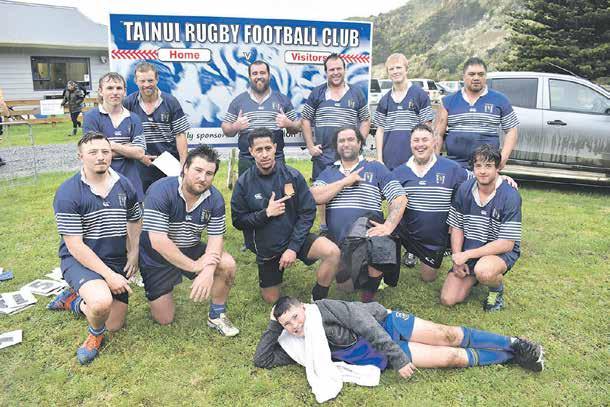
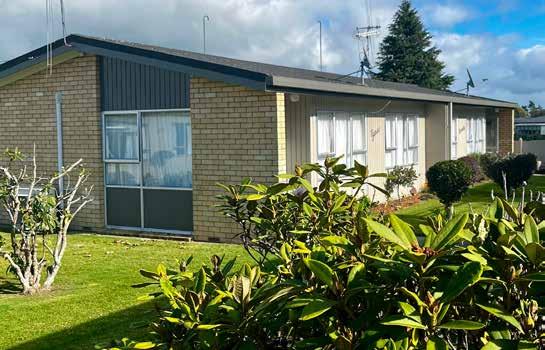
But in latter years rural population declines had gutted rugby clubs, illustrated by 2023 census figures putting the population of Mōkau as 100 and that of Urenui just 430.
“You can see why we had a wide range of ages (18 to 48 for Mōkau), fitness levels and quite a few fellas from outside our areas making up the numbers,” Davis added.
Both teams fielded players from Inglewood on Saturday and Mōkau borrowed additional players from Māhoenui and Āria.
“We even had a couple of players from Tokoroa whose dads had Tainui affiliations.”
Davis said it had been a big community effort for both small centres to stage the game and a huge thanks was due to all involved.
About 60 people from the Mōkau community turned out to watch and the Mōkau Museum commissioned New Plymouth videographer Keith Finnerty to make a documentary of the match. This would eventually be screened alongside other historic films at the Museum’s movie theatre.
“Urenui are just as passionate as us to keep it going. We never practice but we all love playing. I have played for Mōkau for the past 10 years, including alongside a lot
of good mates who had moved on to representative footy. I feel proud that I can still strap the boots on and play because a lot of us now can’t,” Davis said.
“The Urenui trophy itself has been retained by Mōkau for the past eight years, and Saturday’s loss did not change that. It resembles the Bledisloe in that the challenger needs two consecutive wins to secure it. We beat Urenui 28-19 in an away match on August 2, so we’ve retained the trophy again this year. Saturday’s game was just for the bragging rights.”
Davis said the level of rugby the Tainui Rugby Football Club had now was the consolidation of everything which had gone before.
Earlier in the year a planned game against New Plymouth’s Spotswood United, was cancelled.
“So Saturday’s game has kept the rugby fire going at Tainui Domain for another year and I’m optimistic we’ll have rugby games there again next year.”
And though Tainui struggled to assemble teams these days this had led locals to try harder and be stronger, Davis said.
“And we own a superb multiuse clubrooms plus a rugby venue described as being among the 10 most beautiful in the country. We just need the players.”
Discover our charming one- and two-bedroom cottages at Cambridge Resthaven, where you can enjoy a vibrant community atmosphere in the heart of our retirement village.
These classic brick cottages, built in the 1970s and 1980s, are available to occupy under an Occupation Right Agreement (ORA) basis, starting from $360,000. There is 50/50 shared capital gain benefit if the ORA value has increased when you leave.
Contact: Sandra Fairhurst 07 827 6097
On page 1 today we reported that an Ōtorohanga couple had effectively gifted their community an amazing library tracing the community’s recent history. Paul Charman continues the story –explaining what has prompted them to cross the Tasman.
By Paul Charman
After more than 60 years in Ōtorohanga, Richard and Ruve Wallace are moving to Western Australia to be closer to family.
For many such a decision would happen over months, maybe years, but in their case it took, perhaps, an hour.
Richard said he hadn’t considered the move till he and Ruve had afternoon cuppa with his friend Neil Pratt in June.
By the end of the conversation with the national trap shooting champion, they were making plans to put their house on the market.
“I arrived home from my bike ride in the late afternoon, and our friend Neil was having coffee with Ruve. Over discussion something about family had come up and the fact that we have no family at all in New Zealand. Our son lives in Europe and our daughter and her husband live in Western Australia in a small town south of Perth. They have two married children, with five great grand children between them.
“Neil picked up on this and said, ‘what are you doing in New Zealand cut off completely from your family, where you can make an input and add something to their
lives? Because let me tell you Richard, a picture on the wall of you two is absolutely meaningless to those little children. But when they are sitting on your knee and you are telling them stories you become real and valuable’.
“So Neil spoke like a lawyer for about an hour, giving all the reasons why we needed to get to Australia at the end of our lives and enjoy the family and make an input into it.
“And he finished by saying, ‘when I put a shell in my shotgun, it will stay like that forever until I pull the trigger. I am going now and I am telling you that you should pick up the phone and dial Western Australia and pull the trigger. There will be a wave of joy come down the line that you are going to go and live with them.
“So he left, and I picked up the phone and dialled Western Australia and a wave of joy really did come down the phone as I said we are moving from New Zealand to live with you for the rest of our lives.”
Richard and Ruve sold their house fully furnished within five days. Since then they have been down-sizing with the aim of completing the move before the end of the year.



By Sigrid Christiansen
Five Te Kūiti High School students celebrated success at the Kī-o-rahi nationals in Huntly last weekend.
Kī-o-rahi is a fast-paced Māori sport played with a small round ball called a kī on a circular field, with eight players in opposing teams. The two teams are known as Kīoma and Taniwha. Taniwha must stop Kīoma from scoring by ripping tags worn around the waists of the other team’s players. Both teams can score points by different means.
The national tournament featured eight teams and four Te Kūiti students were in the two which made the final – pitting school mates against each other.
Mitchell Hedley and Cheyla Heta-Cloke played in the top-ranking team New Zealand
Secondary Schools while Karen Hodgson and Chance Taylor featured in an invitational team which finished second.
Riddick Rangitonga played for the Aotearoa Māori side, which finished fifth, having won the tournament in 2023. The team was coached by Nano Te Whare and assistant manager was Te Oranga Anderson. Both are Te Kūiti High School staff. Te Whare’s children also did well in the tournament. Libby Kearins Te Whare was named most valuable player, and her brother Koewyn was part of the top team.
Teams were formed specifically for the tournament, so players had to connect in only a few hours, Te Whare said. Each team was billeted at a different marae.
Next up for Te Kūiti High School is the junior regionals in the South Waikato followed by junior nationals in Taupō.
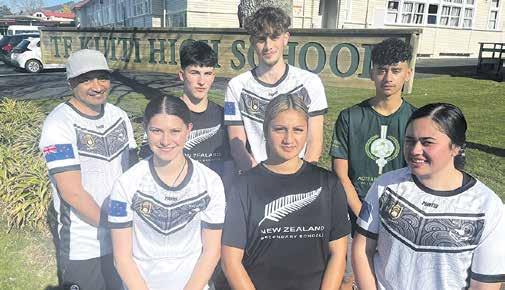






The population of Hamilton has grown 55 per cent as it has matured from a rural support town to a metropolitan city. Chris Gardner talks to the man who has a ringside seat.
When Blair Bowcott joined Hamilton City Council in 1999, the city’s population was 119,400.
Quarter of a century later it’s up to 185,300 and is now the fastest growing city in the country – and its population the youngest - which makes Bowcott’s job as general manager of growth an influential one.
Hamilton has grown up and established its space on the national spectrum, Bowcott said.
“We’ve clearly stamped our mark as a metropolitan city.”
Metropolitan in the context of the region’s wider economic engine of Cambridge, Huntly, Morrinsville, Ngāruawāhia, Taupiri and Te Awamutu.
Born in Te Kūiti, he joined the council as finance and administration unit manager in 1999. He has filled several positions in the local authority, including acting chief executive after Michael Redman left in 2010 and before Barry Harris started less than a year later.
“When I came here, we were growing but it was very much Hamilton thinking about itself, it wasn’t really in conjunction with the other partners,” he said.
Rototuna was a smaller residential development than it is now, and there were large rural areas between the CBD and the city boundary, particularly around Rotokauri, Te Rapa North and Peacocke in the south.
“Hamilton had a lot of rural areas within that boundary, so the conversations then were that we engaged with our neighbours, but we weren’t really running up against them, because we all had land to spare and infrastructure capacity,” Bowcott said.
“Now Hamilton is building out to the boundary on most fronts, so any conversation around further growth of Hamilton really is in partnership
with neighbouring councils.
“Now we’re all about boundaryless planning, boundaryless thinking, boundaryless solutions, working with our neighbouring partners, councils, iwi, councils, and government around how we think about it and build the city of the future. The conversations are far more encompassing.”
The conversation has become more prescriptive since the Local Government Act introduced the promotion of cultural, economic, environmental and social wellbeings.
“The whole framework in terms of how we build, and deliver has changed. The scale of the conversation, the numbers, the challenges and opportunities are just that much bigger. Our conversations with the government are as a partner, as an influencer, whereas back then it was a more of a recipient.”
The council’s relationship with Waikato Tainui has also matured following the $170 million Treaty of Waitangi settlement of 1995, the completion of 87,000 square metre shopping centre called The Base in 2010, and the 30ha Ruakura Inland port operated in a joint venture with Port of Tauranga.
“They are a major investor partner in the city and that has been the fundamental change,” he said.
“The Base has been massive, but the inland port was that next level of maturity. The inland port has really changed how Hamilton is seen as well. It’s brought a new sector to the economy. The opportunity was always there, and you saw that with their Te Rapa development. It’s great to see where the partnership is now.”
So how has Hamilton growth impacted the surrounding districts?
“Our location, our natural offerings, our way of life, has been a big driver for growth,” Bowcott said.
“I think of the Māori proverb
‘a rising tide lifts all boats’. We’ve all lifted with that growth. You’ve seen it with the satellite towns to Hamilton: Cambridge, Te Awamutu, Te Kowhai, Whatawhata, Ngāruawāhia, Tamahere, Matangi. It’s all really rising off that wider economic eco system. The Waikato Expressway has been a major enabler for Cambridge, it has opened and given Hamilton a different perspective.”
As satellite communities grow, Bowcott is concerned it is done in an integrated and planned way.
“We plan together, we think about where likely supply will come from and what the demand is, and we ensure that we are all working together to provide that. It’s been great to see the vibrancy of those towns lift. We obviously have a massive rural residential population around the city. In the last decade we have worked with the neighbouring councils to limit the amount of that residential around the city. We want to ensure that the city can expand in the future, and some of those rural residential settlements on the boundary make it quite challenging, some of that may be on the highest valued land which may be better used for rural purposes, as opposed to being carved up.”
Bowcott gave Co-Lab and Future Proof as examples of the council working with other local territorial authorities and, in the case of Future Proof, iwi and government departments as well.
Co-Lab is a council-controlled organisation that helps members share opportunities, and Future Proof, a forum for councils, iwi and government departments which next meets on September 5, is an example of joined up thinking.
“That partnership thinks about growth in an integrated manner, how we join up and deliver solutions together, including transportation,” Bowcott said.
“It’s important when we think about growth, and partnership with iwi, and councils, it’s not just about the land use, it’s about how we fund the infrastructure that enables that land use.”
“The rate of growth is putting extreme pressure on our systems.”
With that pressure has come high expectations.
“Community expectations of the city have lifted. People expect the environment to be highly respected, high-quality amenity, good transport connections, good community facilities. The scale of what we now think about today, versus what we were dealing with back then, are just that much bigger. The implications are that much larger because of our population, our size, what we’re thinking about is bigger as well.”
Twenty years ago, Temple View was absorbed into the Hamilton city boundaries from Waipa District. Bowcott described the absorption of further settlements on the city boundary such as Matangi, Newstead, Ngāhinapōuri, Ōhaupō, Rukuhia, Tamahere and Tauwhare as “highly politically challenging”.
“There will be some targeted expansions of the boundary around the city where areas are identified for growth. But a significant reach out to capture villages and communities will be a far bigger conversation driven by other factors.
“There have been various organisations calling for reform of local government and consolidation that may occur in the future.”
Water reform with joined up entities, for example.
“I’m not sitting here saying let’s try and expand and capture those villages, I’m saying let’s work with those councils really closely to understand their aspirations for those communities and how they best connect in with Hamilton and how we can deliver joined up solutions.”

Blair Bowcott was born and raised in Te Kūiti but considers himself a Hamiltonian.
He graduated from Waikato University in 1990 with a BMS Hons in Accountancy and Finance after attending Te Kūiti High School in Years 9 and 10 and Hamilton Boys High School in Years 11 to 13.
After university, Bowcott worked for Ernst & Young becoming a qualified chartered accountant, then worked as an accountant for Fletcher Aluminium.
Bowcott joined Hamilton City Council as finance and administration manager in 1999 before serving as acting general manager of corporate services between September and December 2007 when he became deputy chief executive and general manager of programme and finance. He was acting chief executive from November 2010 until April 2011 when he became general manager of performance.
From 2015 he served as executive director of special projects and became general manager of growth three years ago.
Waikato Business News asked Blair Bowcott about the highs and lows of his 25 years in public service at Hamilton City Council.
“Lots of highlights . . . the coming of Hamilton as a metro . . . I am very much proud of Hamilton City. I take great pleasures in the city that I call home, a city that offers a variety of choices for people.”
“Seeing things that you, your team or colleagues were working on become a reality is particularly pleasing,’ Bowcott said.
Ruakura Inland Port, Peacocke urban zone, Hamilton Gardens, Waikato Stadium and Showgrounds are his highs.
Bowcott said he had very few low points.
“To work in local government for this long, you’ve got to be really passionate, resilient and know to work in an organisation with different people and form strong relationships,” he said.
“It’s no secret I was close to the V8 process, and I was obviously impacted by
that.”
Bowcott was demoted from his role as deputy chief executive in 2012 by chief executive Barry Harris as the council had not been kept well informed during the failed V8 street race event.
“That would have to be one period where it was challenging,” Bowcott said.
“But you learn through those, and you understand what’s really important as a senior staff member and your own integrity and your own values, and you take those lessons and apply that to being a better person for the future,” he said.
“It was certainly a challenging point in my career. I’d like to think that through that process I’ve become an even better version of myself.”
What’s the biggest learning from that?
“Ultimately how resilient and how in the in the face focus and attention that you just trust your own values and you are more resilient than you give yourself credit for. If you trust your own values and your integrity you will come through.”
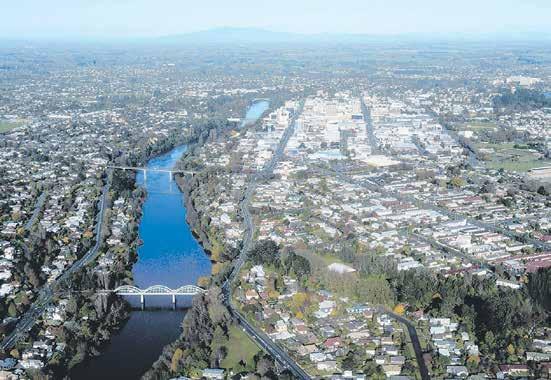
Thirty volunteers spent up to six hours in high winds and rain last weekend helping the Department of Conservation filling bait stations intended to control rats.
The Mapara Wildlife Management Reserve and Conservation Area – in DOC’s Maniapoto region – is home to a significant population of kōkako, the New Zealand bird species featuring on our $50 note.
The reserve is about half an hour from Piopio heading towards Taumarunui.
DOC’s Maniapoto Operations
Manager Graham Kimber was “delighted” with the work of the volunteers.
“Mapara Recreation Reserve is fairly steep and undulating terrain, and our volunteers put in up to six hours of hard physical labour filling some of 2200 bait










stations in the network we have across the reserve,” he said.
“Carrying a large backpack of baits and stopping every 50 metres to fill a bait station requires a lot of energy and commitment.
“To have so many people answer our call for help was very encouraging.
“It shows people really care about nature and our taonga species and are willing to take action to help.”
Former DOC staff member Phil
Bradfield started work at Mapara in 1987, when the kōkako protection at the site was just beginning.
Back then, there were only 16 pairs of the birds – of which only four were breeding pairs.
“We knew kōkako were declining all over the North Island – the project at Mapara was to determine the cause of
the decline, and how we could reverse that.”
Mapara was the first place where intensive predator control was undertaken to protect kōkako. This led to development of prototype bait stations – one of which Bradfield brought to show those involved on Saturday.
Bradfield was encouraged by work at the site, where he spent tens of thousands of hours living in “a rundown shack”.
“I’m absolutely overjoyed the Mapara project is being reinvigorated by a team of volunteers – it’s such a special place for me and kōkako conservation history.”
The baiting was the first of three rounds which will continue through until March 2025.





























































By Andy Campbell
Marokopa Māori are seeking the return of land under the camping ground and former schoolhouse.
Mana Whenua O Marokopa has asked the Waitomo District Council to consider returning the land to them, instead of selling it because it was not currently paying its way.
In recent years the council subdivided the land, separating the old schoolhouse from the camping ground. The schoolhouse has been demolished.
Following a presentation which included the history of the block, including that it was not offered back to the original owners when no longer required for a schoolhouse under the Public Works Act, and sold to the council in 1984-85 for $42,000.
The whānau advised they wish to build a relationship/partnership with the council and work toward having access to services which are not available locally to Marokopa whānau, making use of the property.
“We don’t expect something to come back for nothing, but we do expect a relationship
because that whenua deserves to come back to the hands of the people. We are saying we will look after the community,” the delegation said.
“The proposal is really to pass the whenua back and we will work with you on how that should work.”
The council accepted a recommendation from the Te Raangai Whakakaupapa Koorero (Māori Relations Committee) that council continue to work with the Mana Whenua O Marokopa Work Group on building a relationship for management of the Campground and Old
Giving principal Lyndsay a buzz cut was no trouble for Mana.
When Ōtorohanga College principal Lyndsay Kurth sat down to have her head shaved to raise money to combat blood cancer, the first hands on the clippers belonged to her daughter Morgan.
The year 9 student soon handed over to Year 12 student Mana Tutuila – who through the school’s careers programme, is a trainee barber on work experience at men’s hair salon Cutthroat Brothers, in Te Awamutu.
The college has raised more than $1600 through its Shave for a Cure fundraiser.
He was “a natural” and had shown a real keen interest in his work, his boss
Tyrone Mahe, said.
“He’s been with us since March. He’s not sure if he’ll leave school next year or keep going, but the way he’s progressed through our education pathway so far, he’d get a full-time job with us if that was what he chose to do.”
Lyndsay Kurth said it was an emotional process.
“When I heard the buzz of the clippers and felt the cold steel on my scalp it was more than a physical sensation, it was a journey that echoed the experiences of
those I was there to support.
“As my hair fell, I felt proud for taking the bold step, vulnerable, as my appearance transformed and connected as I thought of those who face the same changes, not by choice, but by necessity.
She said shaving her head was a brief experience, but for those fighting cancer, the journey was longer, harder and often more uncertain.
“By shaving our heads, we honour their courage, we share in their struggle, and we stand beside them in their fight.”
Shave for a Cure is an initiative of Leukaemia and Blood Cancer New Zealand and has raised more than $500,000.
School House property in the future.
A recommendation Te Raangai Whakakaupapa Koorero provide input into the development of a recommendation to council on the management of the land was discussed in the confidential section of that meeting.
In response to a request for the outcome the council’s media person stated there was a ‘really good’ manager looking after the campgrounds now and over time the council will be looking for a long-term solution with all the stakeholders.
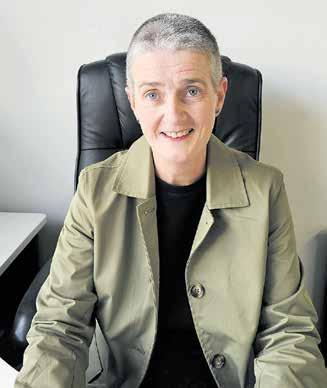













The final tournament of the winter season for the Te Kūiti Bowling Club provided the club an opportunity to acknowledge the work of its greenkeeper.
“Mark Tulip’s efforts over the last three seasons in bringing these greens up to such a high standard and enabling them to be played on during the winter months is quite exceptional,” bowling scribe Clark Ambury said.
The retiring greenkeeper’s efforts had received praise from some of the very best bowlers in the Waikato Centre area, he said.
The tournament was the culmination of two successful winter programmes completed on the traditional grass green. Te Kūiti was the only club to play on grass during winter – other clubs in the Waikato Centre play on
artificial “carpet greens”.
Fourteen teams representing nine clubs took part – there were two four winners and two three winners, one of which missed out on the prizes.
Taking first place was the Frankton Junction team of Steve Liddington (skip), Dean Te Mono and Eddie Knox who headed off the Putāruru side of Noel Sutton (skip), Chen Naude and Graham Hoole by three ends and three extra points. A Te Kūiti trio of Geoff Mc Manus (skip), Jeff Heke and his grandson Bradleigh - playing in a tournament for the first time, took third prize, heading of an Ōtorohanga team skipped by Allan Johnston.
The new season for the club will start on September 7.



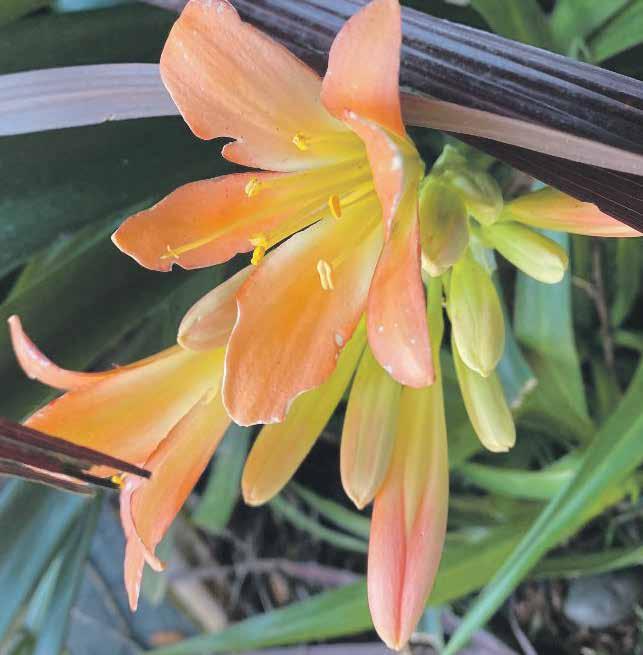
Katrina Christison Tidy Gardens
As the weather starts to warm up before spring, yes spring, next month, now is a great time to get on top of your weeding.
Weeds are the first thing to take off in spring as the soil begins to warm up and you don’t want them setting seed before you weed.
This can spread their seeds though your garden. “Remove a weed now before it has the chance to produce a hundred seeds.”
I like to lay cardboard or newspapers a few layers thick where I have weeded and spread mulch on top as I go. This way if you have left any weeds seeds behind, they are smothered by the mulch.
Spreading mulch also conserves moisture in the soil and as it breaks down improves your soil structure.
Finish off any winter pruning of your roses and deciduous shrubs, removing
the 3 D’s first dead, diseased and damaged, then prune for your desired shape to encourage healthy new growth in spring.
Start getting your veggie bed ready for spring by weeding and mixing in compost and any other yummies like sheep pellets, chook manure etc. so when you plant your veggies they can enjoy all that goodness.
Late winter & early spring is a good time to divide any perennials that you might have that you would like to multiply in your garden.
Dig them up, split into two or three and replant drifted though your garden or even give some away to friends so that they have a piece of your garden in their garden.
I have lots of plants in my garden that came from or were given to me by friends, one that is putting on a show at the moment is a lovely apricot Clivia that came from my husbands late grandmothers garden in Palmerston North.
Happy Gardening!
August 16: The brigade was called out at 2pm after smoke was reported in the vicinity of Taupiri St. A resident in the street had been burning green waste and no action was required.
August 19: At 9.54am the brigade was called out after a tree was reported to be blocking one lane on SH3, about 4km south of Te Kūiti. Inframax was at the scene when the fire appliance arrived and brigade members assisted them to clear the road.
August 17: At 6.15pm the brigade was called
out after a car was reported to be leaking petrol at the Caltex Station in Lawrence St. Brigade members washed the yard down. Later, at 7.21 pm that day, the brigade was called out after a tree was reported to be blocking SH3 north of Blackett Rd. Fire fighters cut up the branches and removed them to the side of the road.
August 15: At 10.15pm the brigade was called out to assist police at the scene of a fatal car crash on SH3 at Māhoenui.
Brigade members assisted police following the incident, which involved a single car that had crashed at about 6pm.


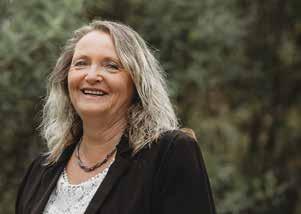



• Transform this charming home into a 5-bedroom haven with concept plans available for the willing buyer
• Prime location on a flat section, close to school and main town
• Kitchen boasts polished floors and all rooms are generously sized
• Windows positioned perfectly off lounge for soaking up the sun
• Versatile bathroom with combined shower, toilet, and shower over bath with back area an extra shower and toilet.
• Generous section with a single shed and plenty of room to grow
• Backyard food garden perfect for the green-thumbed buyer
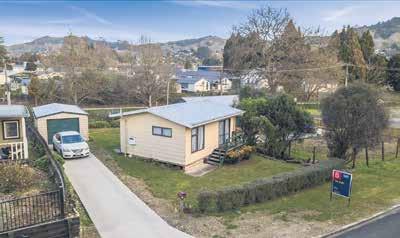







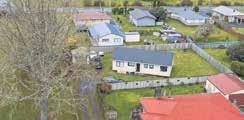








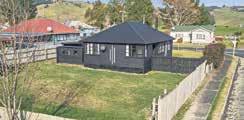



















































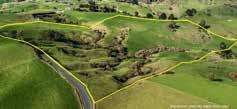























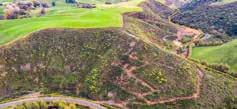









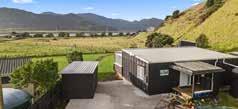













Awamutu 10.30 - 11.00am 73 Raikes Avenue By Neg 3 1 blueribbonharcourts.co.nz/TA23579 11.00 - 11.30am 1/258 Mangapiko Street $649,000 3 1 blueribbonharcourts.co.nz/TA23594 11.15 - 11.45am 277 Churchill Street $495,000 2 1 blueribbonharcourts.co.nz/TA23585
11.45 - 12.15pm 3/746 Mahoe Street $515,000 3 1 blueribbonharcourts.co.nz/TA23634 12.00 - 12.30pm 381 Gleneagles Drive $829,000 3 2 blueribbonharcourts.co.nz/TA23592


12.30– 1.00pm 1/1 Goodfellow Street $730,000 3 2 blueribbonharcourts.co.nz/TA23645 12.45 - 1.15pm 216 Brady Street $675,000 3 1 blueribbonharcourts.co.nz/TA23652 1.00 - 1.30pm 2/294 Mutu Street $665,000 3 1 blueribbonharcourts.co.nz/TA23549 1.15 – 1.45pm 345 Swarbrick Drive $770,000 4 2 blueribbonharcourts.co.nz/TA23633 1.15 - 1.45pm 22 Galloway St, Kihikihi By Neg 3 2 blueribbonharcourts.co.nz/TA23558 1.15 - 1.45pm 2/70












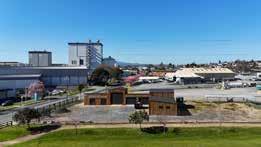






Across 1. Fundamental (5) 4. Excluded, prohibited (6) 8. Overshadow










































































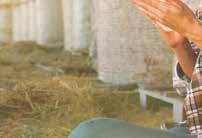





SPLIT FIREWOOD
new season’s, shed stored, 3 cubic metres, $350 delivered Tkt/Oto area.
Fresh sawdust $5 bag. P 027 584 4505 or 07 894 5872.
ROOM TO RENT, in Piopio. Ph 021 0845 4198.
FLAT to rent. Rangipare St, Otorohanga. One bedroom. Suit quiet, clean single person. $325 per week. Contact Mike 021 1569 887.
RENTAL available, tidy, 3 bedrooms + office, double garage, 15 mins from PioPio and 15 mins from Te Kuiti. Ph 027 487 7854
Need somewhere secure to store chemicals?
Purchase a 10, 20 or 40 foot container. Contact PGF Transport for details.
Phone 07 878 3622 or 027 223 9246 or email o ice@pgftransport.co.nz

Situations Vacant Trades & Services

TE KŪITI CATTLE SALE Friday, August 23
Start 12 noon
550 Assorted cattle comprising:
3 Potter bulls
30 MA cows
60 2yr Angus strs
80 2yr Angus hfrs
50 1yr Angus + Exotic x strs
95 1yr H/F + A/F strs
95 1yr Angus + Ang x hfrs
30 1yr Hereford hfrs
95 1yr H/F + A/F hfrs Tidy 3 bedroom house available to rent in Waitomo Village. Elevated position with stunning views over the village. Rent $500 per week. Phone – 027 258 6665 Email – Kayfamily@farmside.co.nz


Dave Rowe
PAINTER & DECORATOR 027 290 8776 • 07 873 9104 • decorator@daverowe.co.nz
Specialising
$$$$ TOP CASH $$$$
$$$$ PAID $$$$ Hiace, Hilux, Corolla, Landcruiser, Liteace, Townace, Trucks, Nizzan vans & utes.
From $200 to $5000
Same day pick up Ph 0800 551 7004



Servicing Ōtorohanga and Waitomo districts
021
and
Property maintenance and construction Lawns, trees, stump grinding, sections, moss & mould treatments, Chemwash, waterblasting, gutter vac, water tank and trough cleaning fences, retaining, odd jobs and more. References available GST registered.
Mike & Allana 027 350 0836 info@handy-man.co.nz

Anything too big for a shovel - give me a call • Vegetation removal • Driveway prep - Auger
• Landscaping • Trenching • Water tanks Manga Roach Ph 027 431 9959

We are recruiting now! Would you like to work for us? We'd love to hear from you. We are currently recruiting for the upcoming 2024/25 summer season for guides, conductors, drivers and maintenance staff. If you're passionate about the Ruapehu region and want to enjoy working outdoors in a positive industry get in touch with us today. CV and cover letter to: careers@fwa.co.nz
Application forms for individuals and organization’s may be printed off the Piopio website or buy emailing the Trust. Email: piopiotrust@gmail.com
Areas covered for grants include Piopio township and the districts of Mairoa – Mangaotaki – Mahoenui – Aria – Mokauiti – Mapiu – Kopaki –Benneydale – Oparure and Rangitoto. Te Kūiti Borough is not included.
Applications close at 5pm on August 31. Late applications will not be accepted.



Protecting native species from introduced predators in Hutiwai, Mohakatino & Waitaanga conservation areas.
The Department of Conservation (DOC) in New Plymouth is going to control possums, rats & stoats over 55,000 hectares. This is scheduled for the first clear weather window after the 1st August 2024. Native wildlife and forests need protection
The National Predator Control Programme is DOC’s ongoing campaign to protect at-risk native species by controlling introduced predators. This campaign is pivotal in strengthening ecosystems through the reduction of devastating pest species populations, helping vulnerable native flora and fauna to revive and be enjoyed for generations to come. Hutiwai, Mohakatino & Waitaanga conservation areas are home to a wide array of native flora and fauna species over a vast area that extends across North Taranaki and into Waikato and ManawatūWhanganui.
Dominated by tawa, kamahi, and beech trees, these forests provide habitat for many native animals including North Island brown kiwi, pekapeka (long and short-tailed bats) whio, and recently rediscovered kōkako.
Why we are controlling introduced predators
Native species are fighting for survival due to predation from rats, stoats and possums. Without protection, we risk losing the unique natural heritage and biodiversity within Hutiwai, Mohakatino & Waitaanga.
Through sustained predator control using 1080, there is a big increase in breeding success for native birds, their food source is more abundant, and the forest canopy is healthier
Our plan to protect native species
The safest and most effective method we have to control possums, rats and stoats over large areas is to use biodegradable cereal bait pellets containing 1080. This bait targets rodents and possums. Stoats are also controlled through secondary poisoning as they feed on the carcasses of the dead rodents.
Helicopters distribute bait pellets across the forest area along pre-determined and monitored flight paths using technology that enables accurate placement. This is the only viable method to control predators in Hutiwai, Mohakatino & Waitaanga due to the vast and rugged terrain.
This operation begins with the distribution of non-toxic pre-feed bait pellets (sandy coloured). This prepares possums and rodents to eat the toxic bait (dyed green) that is applied afterwards. Both baits are about 16 mm in diameter and cylindrical shaped.
Consultation and permissions
DOC has consulted with hapū and iwi, whilst contractors EcoFX have consulted with key stakeholders including landowners adjacent to the treatment area.
DOC is delegated authority by the Environmental Protection Agency to decide applications for permission to use 1080 on land administered or managed by DOC. DOC is in the process of obtaining permission for this operation. DOC is also obtaining the required permission from the Ministry of Health. DOC ensures that all legal and policy requirements are met, and that any potential risks of the operation are managed.
Managing risk
1080 is poisonous to humans, domestic and game animals. In areas where the toxin has been applied, dogs are highly at risk until poisoned carcasses have disintegrated. This takes four-to-eight months or longer.
There will be warning signs placed at entrances to the treatment area immediately prior to the operation. Observe these rules whenever you see warning signs about pesticides.

Risks can be eliminated by following these rules:
• DO NOT touch bait
• WATCH children at all times
• DO NOT EAT animals from this area or within the buffer zone outside the treatment boundary. The buffer zone is 2 km for deer and pigs, 200 m for rabbits, and 1 km for hares, and possums.
• Poison baits or carcasses are DEADLY to DOGS
These signs indicate pesticide residues may be still present in baits and poisoned carcasses. When signs are removed, normal activities can resume. If in doubt, check with your local DOC office. Please report suspected vandalism or unauthorised removal of signs. If you suspect poisoning, please contact:
Your local doctor or hospital OR The National Poisons Centre: 0800 764 766 (urgent calls) or 03 479 7248 OR dial 111.
Seek veterinary advice for suspected poisoning of domestic animals.
For more information
Please contact: Operational planner Biodiversity Ranger, Ngāmotu /New Plymouth Office, 55A Rimu Street, New Plymouth. Email: newplymouth@doc.govt.nz or Phone: 06 759 0350 or EcoFX Aerial Operations Manager, 32 Huiputea Drive, Otorohanga 3900, admin@ecofx.co.nz , 07 873 8130. Visit the DOC website: More information about DOC’s National Predator Control Programme is available on our website www.doc.govt.nz/our-work/national-predator-control-programme
This map shows the area we are controlling possums, rats & stoats to protect native species. You can also see operational updates and detailed maps of predator control on public conservation land on the DOC website. www.doc.govt.nz/nature/pests-and-threats/pesticide-summaries


Do you enjoy singing?
Find out about your local choir at the Waitomo Caves Choir Open Day Saturday, August 31, 2024 Baptist Church, Ōtorohanga
Meet & greet over morning tea from 9.30am, Sing 10am - 12pm
The choir is non auditioned, however, to retain a good balance of voices, spaces may be limited. For more information contact Katrin Woermer 027 203 6595, wcaveschoir@gmail.com

This is a friendly reminder that the first instalment of your 2024/2025 rates is due by 5pm, Friday 30 August 2024. Rates invoices were posted out in July. Payments received after 5pm, 30 August will attract a 10% penalty.
Rates payments can be made at the Customer Service Centre, 160 Rora Street Te Kūiti, over the phone by credit card, on our website or by Internet Banking using your valuation number as your reference.
Please contact our friendly Customer Services Team on 0800 932 4357 for further assistance.
Ben Smit Chief Executive
www.waitomo.govt.nz

Mangarapa Trust AGM
Date: Sunday, August 25, 2024 at 11am
Where: Te Ahoroa Marae RD2, Te Ahoroa Rd, Rangitoto Enquiries to bettyholden@yahoo.com
can
at www.otodc.govt.nz/ about-council/meetings

www.otodc.govt.nz
Email your classified ads to reception@kingcountrynews.co.nz
Don’t forget to include your billing details, name, address & daytime contact phone number

A1 Administration Solutions is located in Te Kūiti township and provides efficient and effective administration services to existing and prospective clients.
We are seeking a part-time Administration Assistant (20-30 hours per week), fixed-term (1 year with the possibility of continued employment) The successful candidate will report to the senior manager and your part in the ongoing success of this entity will see you involved day to day in a variety of duties as follows (but not limited to):
• Answer phone calls and reception duties
• Collect & collate all inward & outward correspondence
• Meeting minutes
• Photocopy, scan, file and bind as required
• Assist with large mailouts
• Order stationery & other items as required
• Book accommodation
• Manage board room bookings
• Organise & order catering requirements
• Keep our office & boardroom clean & tidy
• General office duties
• Support other administration staff as required
This role is suitable for someone with the following skills:
• Pleasant demeanour
• A quick learner with a can-do attitude
• Reliable, dependable, and willing to “Pitch In” at all times
• Organised with strong attention to detail & accuracy
• Good computer skills in Microsoft Office programs
• Excellent communication skills
• High degree of confidentiality
• Ability to work co-operatively with a wide variety of people
• Able to meet deadlines
Training will be given to the successful candidate; however, previous experience would be an advantage.






CAMPBELL, June: 26/6/46 – 21/8/23. Until we meet again. Every beat of my heart are memories of ‘The way we were’ Forever missed. Laurie.
TUTTY, Linda Mary:
Peacefully passed away two years ago on August 20, 2022. Silent memories keep you near, As time unfolds another year. Out of our lives you may be gone, But in our hearts you still live on.
So sadly missed everyday by Colin ,Karl, Aaron, Shaun and families xxx
ROBERTS, Muriel
Mary: On Saturday, August 10, 2024. in her 98th year. Dearly loved Mum of Helen and Murray Brandon. Loved and respected Grandma of Christopher and Lucy, Jenny and Hayden, Rosemary and Andrew and Russell and kelly. Great Grandma of twelve. We will miss your love, wisdom, stories and amazing smile. You have your wings.
SMITH, Dorothy MBE: Dorothy Catherine Smith passed away peacefully in her 96th year at Duart home in Havelock North. Dot was a devoted wife to the late Noble Smith, a loving mother and mother in law to Raey and Ross Hardey, Leigh and Mike Lamb, Murray and Anne Marie Smith. Dot will be dearly missed by her eight grandchildren, Campbell, Jane and Caroline, Kate and Jeremy, Courtney, Bradley, and Alexander. Loved sister of Ron Hardie. In accordance with Dots wishes a private cremation has been held. A small celebration of her life will be held on Saturday, August 24 at 2pm at VJ Williams & Sons Chapel, 33 King Street West, Te Kūiti. If you wish to attend please email the family raeyhardey@gmail. com or text to 027 224 4967 or leighcaughey@ gmail.com or text 021 4954 77.VJ Williams & Sons, Funeral Directors Association of NZ

DOOLE, Barbara Ann:
Peacefully on Saturday, August 17, 2024 at Wilson Carlile Village, surrounded by her loving family. Aged 89 years. Adored wife of the late Alan. Loved mother and mother-in-law of Karen and Jo; Ian; Neville and Donna; Maz and Rick. Loved Nana of all her grandchildren and great grandchildren. A celebration of Barbara’s life to be held at VJ Williams & Sons Chapel, Te Kūiti on Friday, August 23 at 1pm followed by a private cremation. Tributes can be left on our website www.vjwilliams. co.nz/funerals-tributes All communications to Doole Family C/- 34 Unsworth Road, RD7, Rotorua. In the care of VJ Williams & Sons, Funeral Directors Association of NZ
FALCONER, Thomas:
Tom was Treasurer and Chair for the St John Te Kūiti Area Committee for many years. A respected and valued member of St John. Thank you Tom for your service.
GOWER, Lorna June: On Friday, August 16, 2024 at home surrounded by her loving family. Dearly beloved wife of Robin for 65 years. Cherished mother and mother-in-law of Kerry and Alan; Sally and Stuart, Lisa and Colin, Trudi and Paul; and the late Glenn. Adored grandmother to all her grandchildren and great-grandchildren. A private service has been held for Lorna. VJ Williams & Sons, Funeral Directors Association of NZ
AIKMAN, William (Bill): Peacefully at Waikato Hospital on Saturday, August 17, 2024. Aged 88 years. Loved father and father-in-law of Coral and Jeremy; Chris and Diane; Phllip and Carol; Jocelyn and Kevin; Loved poppa of 10 grandchildren and 13 great grandchildren. Special friend to Ross and Chrissie. Much loved friend of Joan and poppa to Roy and Sharon Williams and families. A celebration of Bill’s life has been held, followed by private cremation. Tributes can be left on our website www.vjwilliams.co.nz/ funerals-tributes All communications to Aikman Family C/- PO Box 241, Te Kūiti 3941. In the care of VJ Williams & Sons, Funeral Directors Association of NZ
BURDON, Jean Edith (nee Norman): Passed away so peacefully on August 9, 2024, surrounded by her loved ones, aged 78 years. Dearly loved wife of Brian (dec) - Birdie, of 50 years. Loved daughter of the late Edith and Ivan Norman, sister of Edith Jean (Jean) (dec), Roland and Evelyn (dec). We are all God’s children From the morning-hour of birth
He lets us live and laugh and love And have our day on earth.
He guards us through the afternoon Till sunset’s rays are cast










12.30pm-3pm
7pm The Harvest Centre, 5 Tuhoro St, Otorohanga 07 873 8890 I 027 493 0117 • harvest.pc@xtra.co.nz Pastors Peter & Carole Coventry (An Assemblies of God Church)
Faith is a muscle that grows by stretching (Nicky Gumbel)

MURRAY, Dennis Colin: 26 April 1947 - 18 August 2024. Aged 77 years. Passed away peacefully at home. Loved and cherished husband and soulmate of Brenda, devoted and caring father to Annita, Sharon and Andrew, the greatest poppa to Jack, Sean, Lily, Luke, Vivy, Jade, Marcus, Gemma, Peyton, Brianna, and great grandson Kyraan. Cherished brother, brother-in-law, uncle and friend to many. Now at peace after a courageous and lengthy battle with ill health. Forever in our hearts. A celebration of Dennis’ life has been held, followed by a private cremation. All communications to Murray Family C/- PO Box 241, Te Kuiti 3941. VJ Williams & Sons, Funeral Directors Association of NZ

Country
Then one by one, with gentle words He calls us home at last. Requiem Mass for Jean was held at St Patrick’s Catholic Church, Te Awamutu. Correspondence to The O’Brien’s, C/- 3 Peacock Road, R D 4, Ōtorohanga.
BURDON, Jean Edith (nee Norman): Much loved Mum of Fiona and Jeremy O’Brien. Grandma to Charlie, Thumper and the late: Tawny and Theodora Chipmunk. Left with many precious and beautiful memories, our Christmas will never be the same. Now at peace with Birdie.



































